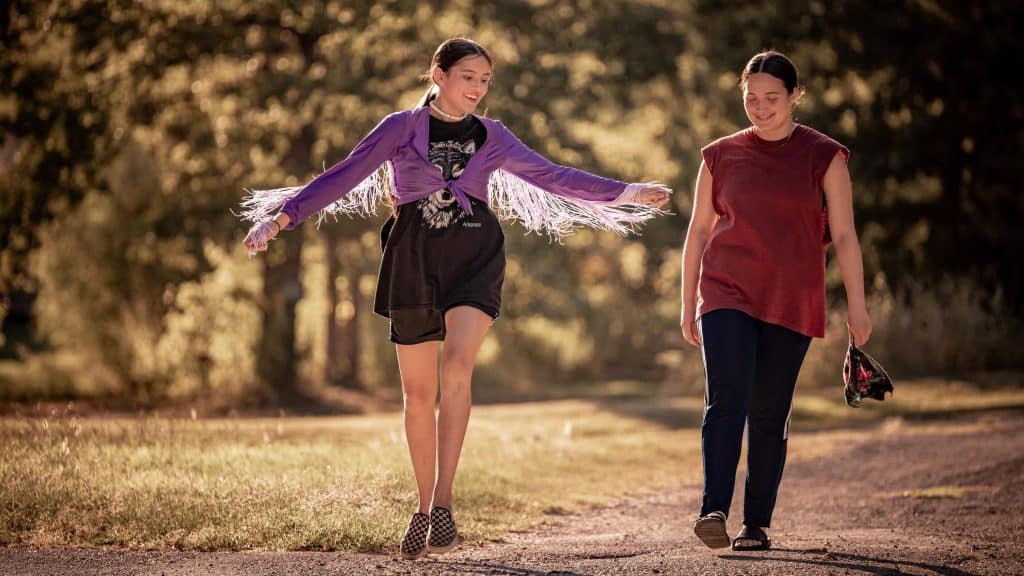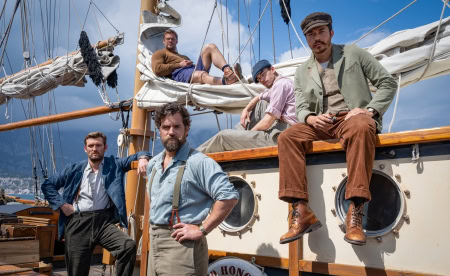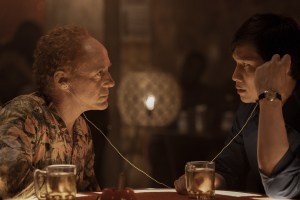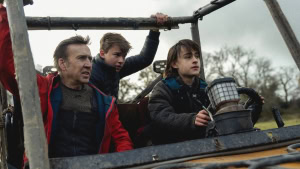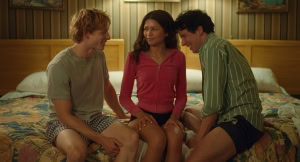The following article contains light spoilers for ‘Fancy Dance.’
We all do dances through life. Some of them are literal, while others are more figurative. But for Erica Tremblay, director, producer, and co-writer of Fancy Dance, you can do both.
“‘Fancy dance’ is a type of [Native] powwow dance, but it’s also emblematic of this dance that the characters are doing as they navigate this very treacherous landscape,” she says, hot off of the film’s premiere at SXSW 2023. “That’s a lot of what being Native means in our modern, colonized culture.”
In the film, aunt-niece duo Jax and Roki traverse their midwestern homeland to attend a powwow, a traditional kind of Native gathering that often includes dancing as a celebration of ancestry and culture. However, they must be light on their feet in more ways than one, as they are both on-the-run from their fractured family, local Child Protective Services, and, eventually, the police.
Despite the dangers, this road trip family story is grounded in love and pride. “We wanted this film to be grounded in humanity and connection versus unnecessary depictions of violence against Native peoples,” says Tremblay. “Dance, whether it’s in powwow or whether it’s in ceremony, is an important part of not only just being but also celebrating being Native.”
In an effort that brought home the film’s communal elements, Tremblay gathered hundreds of extras together to stage an authentic powwow for the film’s final sequence. “It was a really, really wonderful night where the community all came together,” confirms Tremblay. “It was an overnight shoot, so it was a long night, but it was also an emotional shoot due to the nature of what we were shooting. We were so grateful to the community for coming out and really supporting us.”
Following its premiere at this year’s Sundance Film Festival, the film screened in South By’s Festival Favorites section and will go on to open the Sun Valley Film Festival on March 31. The film has received positive reviews thus far and was acquired for worldwide distribution by Cercamon.
Tremblay sat down with GVN to discuss the significance of powwows, the film’s queer and Native elements, and the process of casting both Lily Gladstone and Isabel Deroy-Olson as Jax and Roki. Here is that conversation, edited for length and clarity.
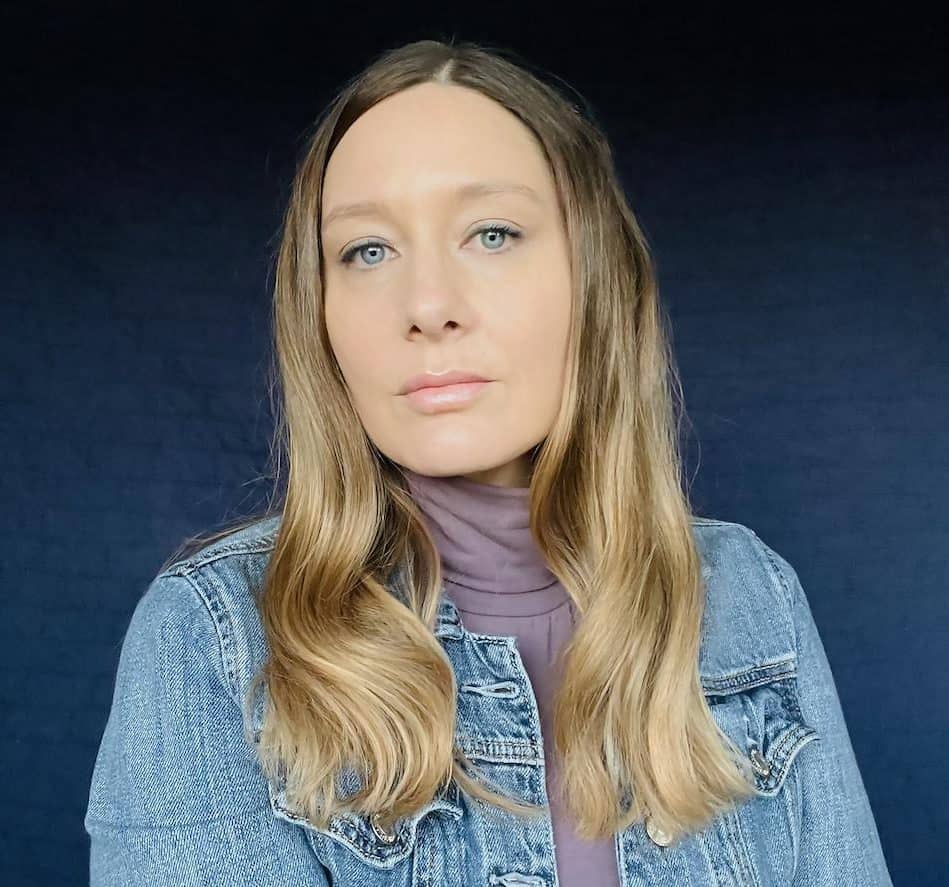
It might be an obvious place to start, but what was the inception behind this story? How personal of a story is this for you?
I’m from the Seneca-Cayuga nation and I grew up in and around my community in Northeastern Oklahoma and Southwest Missouri. I wouldn’t say that the film is biographical in any way, but I definitely drew from experiences being a Native woman and living in Native communities. As a person who is studying language and is hoping to invest in the language revitalization of the Cayuga language, I really wanted to imagine a modern day world where young people spoke the Cayuga language fluently and where matrilineal kinship is the backbone of their relationships. I thought it would be great to explore a story between an aunt and a niece and ground their journey through this oppressive landscape but also through their love and connection for each other.
There is a utopian aspect of getting to create a world that you want to see, but often when you’re telling stories about groups that have not gotten a lot of exposure in cinema, there’s a pressure to tell the story in a way that feels grounded. Was there an aspect of balance in creating something you’ve never seen in cinema before while still wanting to accurately portray these communities that you come from?
I do think that there was a real drive to try and stay grounded in the reality of these relationships. My co-writer, Miciana Alise, is also an indigenous woman, and while we were writing the script, we were constantly thinking about our own communities. There were times when we made choices in an effort to not retraumatize our communities––maybe there are some harsh truths that we left on the periphery because we wanted this film, again, to be one that’s grounded in humanity and connection versus unnecessary depictions of violence against Native peoples, which we see all too often being handled by non-Native writers and directors in a not-super-productive way, in my opinion. The goal was to show up and be honest every day.
The queer elements of the story really inform Lily Gladstone’s character in a significant way. Was that always initially in the conception of the film or was it something that grew out of building the story further?
As a queer person myself, I wanted to lean in on experiences that I’ve had in the world. For a long time when talking about queer cinema, it had to be grounded in that identity so greatly and the suffering of being queer so greatly, but when we watch movies about straight people who have relationships with other straight people, we don’t sit and analyze it. “Oh my gosh, he has a wife!”
[laughs]
It’s strange. For me, Jax is a queer woman and is traversing the world as a queer Native woman. It was more interesting not that she was queer, because to me that’s just normal, but rather why she can’t have a committed relationship. Well, she can’t have a committed relationship because she doesn’t have the capacity to love or be loved due to what she’s traversing emotionally on a daily basis. For her, the only way to have intimacy is transactional. She goes to the strip club and meets the person that she wishes she could be in a relationship with, but the only way that she can manage it is if she’s paying for this intimacy. For me, it was also about showcasing a moment of consensual queer sex work. It was a fun world for me to explore and not one that we see often. I worked in strip clubs all through college and for years after. I have also been a sex worker. When I watch movies or TV shows that have strip club scenes, I’m like, “this person’s never been in a strip club dressing room if they think that this is what it looks like.” In reality, we’re all fighting over one mirror and one hanging light. That aspect of Jax and the sex work world was a cool playground and was always part of it.
So much has been said about the casting of Lily Gladstone as Jax, but what I’m really interested in is the co-casting of both Lily and Isabel [Deroy-Olson] as Roki. What were you initially looking for with this central relationship and then what did these two bring to it?
Lily was a part of the project from the inception. She read all the drafts along the way and was attached to the film the whole time. She’s a dear friend of mine, an incredible collaborator, and a deeply, deeply talented human being. As soon as we had any soft money at all, we brought on a casting agent. We knew we needed to find a young woman to play Roki. I work on Reservation Dogs and we brought on the same casting agent [Stacey Rice]. We had done a pretty exhaustive search and met incredibly talented young women but hadn’t quite found our Roki yet, and I was casting an episode of TV that I had written for AMC and this young girl’s tape came across my desk. She was too young to play the part we were casting [for AMC], but I immediately reached out to Isabel’s reps and I was like, “I have this other movie, would you want to audition?” She did and I was blown away by her maturity. She is a jokester but very opinionated about things, very kind but also strong-minded.
Because Lily’s star power is so massive, I knew that we needed someone that wouldn’t just disappear behind Lily. We had two weeks of rehearsal where for the first four hours of the day they would do language classes together and in the second four hours they would do dance lessons, and they just loved each other. They would pull practical jokes and razz each other. They sincerely bonded and I think that magnetism came out in their performances. You believe that these two really care about each other because I think they really did. Lily’s working on a TV show in Vancouver where Isabel lives and sometimes they’ll text me, “We’re having dinner.”
Aw, that’s amazing.
They’ve gone on to have a relationship with each other after the project.
I’d love to talk more about some of the Native elements of the film, specifically the powwow. What exactly is the cultural significance of the powwow and why was it such a foundational aspect for Roki’s character?
Powwow is a lot of different things in a lot of different communities. It originated during a time in the US where it was illegal for Natives to practice their ceremonies, [but powwow] was something that Natives could do to come together and celebrate their indigeneity legally. It’s got a fraught and violent creation story. Non-Natives were able to come and watch it, which is weird, but over many, many, many years, powwow has evolved into more of a gathering and celebration of being Native. A lot of people come together and it doesn’t matter what tribe you’re from, everyone can experience the dance and the fellowship together. For Roki, she and her mother celebrated being Native together by going to this powwow every year and participating in a dance competition. For me, it was a way of getting Roki and Jax together at the end, sharing joy and love. We made this film during the pandemic and it was a large feat to bring hundreds of extras together, but it was a really, really wonderful night where the community all came together and essentially threw our own powwow.
I was going to ask, did you stage that entire powwow for the shoot?
Yeah, we did. We were so grateful to the community for coming out and really supporting us. It was an overnight shoot, so it was a long night, but it was also an emotional shoot due to the nature of what we were shooting. Dance, whether it’s in powwow or whether it’s in ceremony for many Native cultures, is really an important part of not only just being but also celebrating being Native. “Fancy dance” is a type of powwow dance, but it’s also emblematic of this dance that the characters are doing as they navigate this very treacherous landscape. That’s a lot of what being Native means in our modern colonized culture. Then we tie that back into the mother dancing at a strip club to make ends meet and to provide her daughter with what she needs to live and grow up. Dance is an incredibly important part of the film in a lot of different ways and it was really fun to get to explore all of those different types of dancing in the film.
Fancy Dance screened as part of the Festival Favorites section at SXSW 2023. It has its World Premiere at the 2023 Sundance Film Festival and is set for worldwide release at a date TBD.

Larry Fried is a filmmaker, writer, and podcaster based in New Jersey. He is the host and creator of the podcast “My Favorite Movie is…,” a podcast dedicated to helping filmmakers make somebody’s next favorite movie. He is also the Visual Content Manager for Special Olympics New Jersey, an organization dedicated to competition and training opportunities for athletes with intellectual disabilities across the Garden State.


